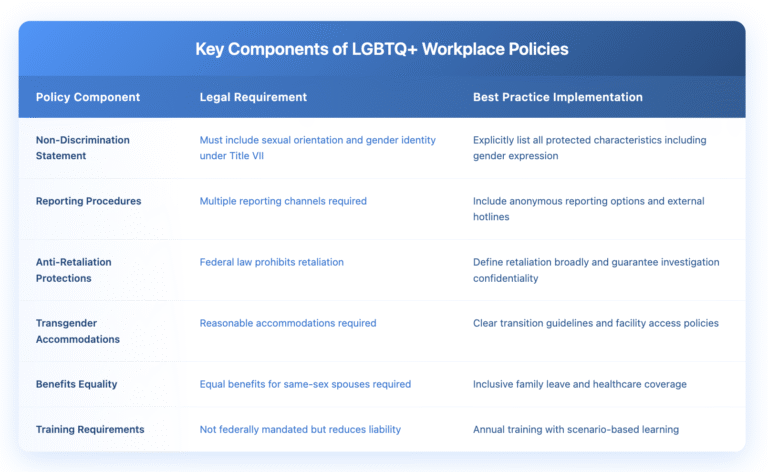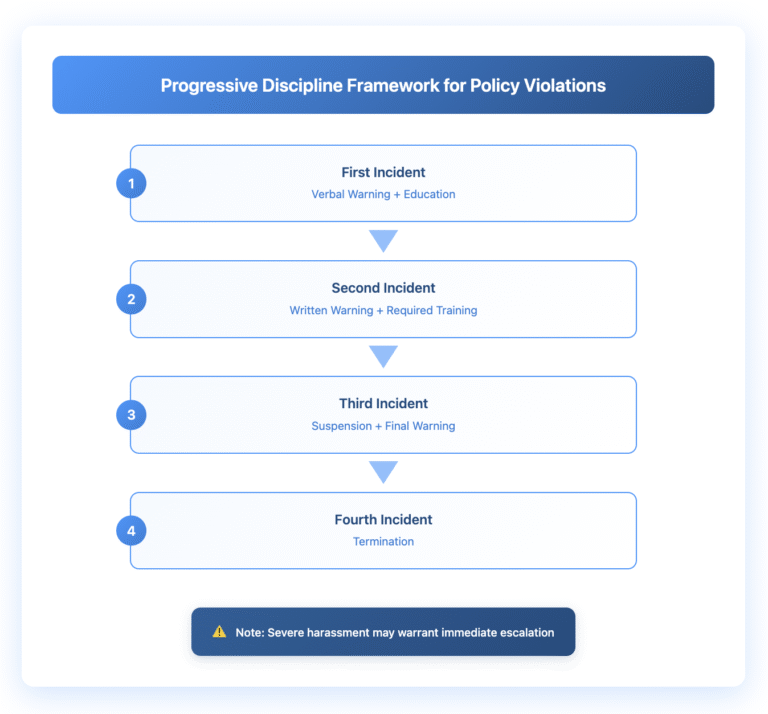If you’re reading this, you’re likely trying to understand what workplace policies actually protect LGBTQ+ employees from discrimination. Whether you’re an employee wondering about your rights or an employer working on compliance, here’s what you need to know: effective LGBTQ+ inclusion policies go beyond basic non-discrimination statements. They require specific, legally sound frameworks that address real workplace situations.
Since the Supreme Court’s Bostock v. Clayton County decision in 2020, Title VII of the Civil Rights Act protects employees from discrimination based on sexual orientation and gender identity nationwide. But legal compliance is just the starting point. Let’s break down what comprehensive workplace policies should include and how they function in practice.
Disclaimer: This article provides general information for informational purposes only and should not be considered a substitute for legal advice. It is essential to consult with an experienced employment lawyer at our law firm to discuss the specific facts of your case and understand your legal rights and options. This information does not create an attorney-client relationship.
Core Non-Discrimination Policy Components
Your workplace’s non-discrimination policy needs explicit language protecting LGBTQ+ employees. Generic statements about “treating everyone fairly” don’t cut it legally.
The policy must specifically list sexual orientation, gender identity, and gender expression as protected characteristics. This clarity matters because courts look at whether policies clearly communicate protections when evaluating discrimination claims. The EEOC emphasizes that policies should use current, respectful terminology and be easily accessible to all employees.
What Makes a Policy Legally Effective
A legally sound LGBTQ+ non-discrimination policy includes several key elements. First, it defines protected categories clearly – explaining what sexual orientation, gender identity, and gender expression mean in practical terms. Second, it outlines specific prohibited behaviors, not just broad concepts.
For example, rather than just stating “discrimination is prohibited,” the policy should specify: refusing to use an employee’s chosen name and pronouns, denying promotion opportunities based on sexual orientation, or creating different standards for LGBTQ+ employees. These specifics help employees understand their rights and help employers enforce consistent standards.

Transgender and Gender Non-Conforming Employee Protections
Workplace policies must address the specific needs of transgender and gender non-conforming employees. This isn’t optional – it’s a legal requirement under federal employment law.
The EEOC has made clear that denying transgender employees access to facilities consistent with their gender identity constitutes sex discrimination. Your policy needs to explicitly state that employees have the right to use restrooms and other facilities that correspond with their gender identity. Some workplaces also provide all-gender or single-occupancy facilities as additional options, but these cannot be the only option offered to transgender employees.
Workplace Transition Guidelines
When an employee transitions at work, having clear guidelines protects both the employee and the employer. These guidelines should address practical matters like updating personnel records, email addresses, and identification badges with the employee’s chosen name and correct pronouns.
The policy should also establish that asking invasive personal questions about an employee’s transition or medical procedures is inappropriate and potentially illegal. Privacy protections are crucial – an employee’s transgender status and transition-related information should be kept confidential unless the employee chooses to share this information.
Name and Pronoun Policies That Work
Respecting employees’ chosen names and pronouns isn’t just polite – repeated, intentional misgendering can create a hostile work environment under federal law.
Your policy should require using the names and pronouns employees designate, regardless of what appears on legal documents. Many employers now include pronoun fields in email signatures and employee directories, making it easier for everyone to use correct pronouns consistently. The key is making these practices standard rather than singling out LGBTQ+ employees.
Addressing Resistance and Mistakes
Let’s be practical: not everyone will get pronouns right immediately, and some employees may resist these policies. Your framework needs to distinguish between good-faith mistakes and intentional harassment.
Occasional slip-ups, followed by quick self-correction, are different from persistent refusal to use correct names or pronouns. The latter constitutes harassment and requires progressive discipline. The policy should outline consequences for intentional misgendering, starting with coaching and escalating to termination for repeated violations.

Benefits and Family Leave Equality
Federal law requires employers to provide equal benefits to employees in same-sex marriages. But comprehensive policies go further, ensuring all family structures receive equal treatment.
Your benefits policy should explicitly cover same-sex spouses and domestic partners where applicable. Family and medical leave policies need inclusive definitions of “family” that recognize chosen families and non-traditional family structures. This includes parental leave for LGBTQ+ parents through adoption, surrogacy, or other family-building methods.
Healthcare Coverage Considerations
Healthcare benefits require particular attention. Policies should ensure coverage for transition-related healthcare for transgender employees when medically necessary. Exclusions for transition-related care may violate federal civil rights laws.
The Department of Health and Human Services has indicated that categorically excluding transition-related care constitutes discrimination. Review your healthcare plans to ensure they don’t contain discriminatory exclusions and that mental health services are equally accessible to LGBTQ+ employees.
Anti-Harassment and Hostile Environment Prevention
LGBTQ+ employees face harassment at significantly higher rates than their peers. Your anti-harassment policy needs teeth to actually protect employees.
The policy must clearly state that harassment based on sexual orientation or gender identity violates company policy and federal law. This includes verbal harassment like slurs or offensive jokes, physical harassment, and visual harassment like offensive images or gestures. The policy should emphasize that harassment from customers, vendors, or other third parties won’t be tolerated either.
Creating Effective Reporting Mechanisms
Employees need multiple ways to report discrimination or harassment. Not everyone feels comfortable reporting to their direct supervisor, especially if that supervisor is the source of the problem.
Establish several reporting channels: HR, a dedicated hotline, an ethics committee, or an ombudsperson. Anonymous reporting options increase the likelihood that problems get reported before they escalate. The policy should guarantee that all reports will be investigated promptly and thoroughly, with clear timelines for resolution.
Training and Education Requirements
While federal law doesn’t mandate LGBTQ+ inclusion training, it significantly reduces legal liability and creates better workplace cultures. Effective training addresses unconscious bias, not just overt discrimination.
Training should be interactive and scenario-based, helping employees understand how policies apply to real situations. For example, discussing how to handle a client who refuses to work with an LGBTQ+ employee, or addressing concerns about pronoun usage. Management needs additional training on handling complaints, recognizing discrimination, and supporting LGBTQ+ team members.
Measuring Policy Effectiveness
Having policies on paper means nothing if they’re not enforced. Regular audits help identify gaps between policy and practice.
Track discrimination and harassment complaints involving LGBTQ+ employees, looking for patterns. Survey employees about their experiences and whether they feel safe being open about their identity at work. Exit interview data can reveal problems that current employees might not feel comfortable reporting. Use this data to refine policies and address systemic issues.

Legal Compliance Across Jurisdictions
While Bostock provides nationwide baseline protections, many states and cities have additional requirements. New York, for instance, requires specific sexual harassment training that includes LGBTQ+ issues.
Some jurisdictions mandate gender-neutral bathroom access or have stricter standards for hostile work environment claims. If you operate in multiple locations, your policies need to meet the highest applicable standard. This prevents confusion and ensures consistent protection for all employees.
Religious Exemptions and Limitations
Some religious organizations have limited exemptions from LGBTQ+ anti-discrimination laws. However, these exemptions are narrow and don’t apply to most employers.
The religious exemption typically applies only to positions performing religious functions. A religious hospital, for example, generally cannot discriminate against LGBTQ+ nurses or administrative staff. Even religious organizations must be careful about creating hostile work environments. Courts increasingly find that harassment goes beyond any religious exemption.
Documentation and Record-Keeping
Proper documentation protects both employees and employers. Your policy should specify what records will be kept and for how long.
Document all complaints, investigations, and resolutions. Keep training records showing who attended and when. Maintain records of policy updates and communications. If an employee requests accommodations or reports discrimination, document the response and any actions taken. These records prove compliance efforts and can be crucial in defending against discrimination claims.
Privacy and Confidentiality Protocols
LGBTQ+ employees may not be “out” to everyone in their lives. Your policies must protect their privacy while still allowing for necessary workplace accommodations.
Establish clear protocols about who has access to information about an employee’s sexual orientation or gender identity. Transition-related information should be treated as confidential medical information. The policy should specify that “outing” an employee without permission constitutes a serious violation.
Building Inclusive Culture Beyond Compliance
Legal compliance is the floor, not the ceiling. Truly inclusive workplaces go beyond avoiding lawsuits to creating environments where LGBTQ+ employees thrive.
This might include establishing LGBTQ+ employee resource groups, participating in Pride events, or bringing in LGBTQ+ speakers. It means reviewing seemingly neutral policies – like dress codes or parental leave – through an inclusion lens. When leadership visibly supports LGBTQ+ employees, it sends a powerful message about organizational values.
Next Steps: Implementing and Enforcing Your Policies
Having read through these requirements, you might be wondering whether your workplace policies provide adequate protection. Here’s what to do next:
First, audit your current policies against these standards. Look for gaps in coverage or vague language that could leave LGBTQ+ employees vulnerable. Second, ensure your reporting mechanisms actually work – test them anonymously if possible. Third, invest in comprehensive training that goes beyond checking boxes to create real understanding.
If you’re facing discrimination despite workplace policies, document everything. Keep records of incidents, including dates, times, witnesses, and any reported complaints. Federal law requires filing an EEOC charge within 180-300 days of discrimination, depending on your state, so don’t wait to seek legal guidance.
For employers, remember that strong LGBTQ+ inclusion policies aren’t just about avoiding lawsuits. They help attract and retain talent, improve workplace culture, and demonstrate commitment to equality. Companies with inclusive policies consistently outperform their peers in employee satisfaction and business outcomes.
When Legal Support Becomes Necessary
Sometimes, even the best policies fail to prevent discrimination. If you’re experiencing harassment that your employer won’t address, facing retaliation for reporting discrimination, or being denied equal treatment despite company policies, legal intervention may be necessary.
Employment discrimination cases require specific evidence and have strict deadlines. Whether you need help understanding your rights, filing an EEOC charge, or pursuing litigation, experienced legal counsel makes a difference. At Nisar Law Group, we help LGBTQ+ employees navigate these complex situations and hold employers accountable for discrimination.
Don’t wait until discrimination escalates or deadlines pass. Contact Nisar Law Group today for a consultation about your workplace rights and legal options. We’ll help you understand whether your employer’s policies meet legal requirements and what recourse you have if they don’t.


